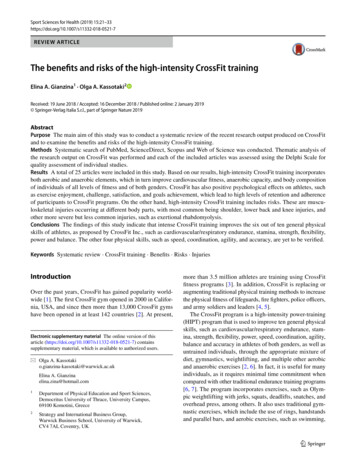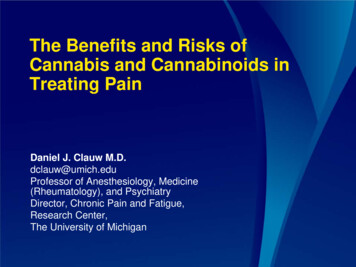
Transcription
Sport Sciences for Health (2019) 7REVIEW ARTICLEThe benefits and risks of the high-intensity CrossFit trainingElina A. Gianzina1 · Olga A. Kassotaki2Received: 19 June 2018 / Accepted: 16 December 2018 / Published online: 2 January 2019 Springer-Verlag Italia S.r.l., part of Springer Nature 2019AbstractPurpose The main aim of this study was to conduct a systematic review of the recent research output produced on CrossFitand to examine the benefits and risks of the high-intensity CrossFit training.Methods Systematic search of PubMed, ScienceDirect, Scopus and Web of Science was conducted. Thematic analysis ofthe research output on CrossFit was performed and each of the included articles was assessed using the Delphi Scale forquality assessment of individual studies.Results A total of 25 articles were included in this study. Based on our results, high-intensity CrossFit training incorporatesboth aerobic and anaerobic elements, which in turn improve cardiovascular fitness, anaerobic capacity, and body compositionof individuals of all levels of fitness and of both genders. CrossFit has also positive psychological effects on athletes, suchas exercise enjoyment, challenge, satisfaction, and goals achievement, which lead to high levels of retention and adherenceof participants to CrossFit programs. On the other hand, high-intensity CrossFit training includes risks. These are musculoskeletal injuries occurring at different body parts, with most common being shoulder, lower back and knee injuries, andother more severe but less common injuries, such as exertional rhabdomyolysis.Conclusions The findings of this study indicate that intense CrossFit training improves the six out of ten general physicalskills of athletes, as proposed by CrossFit Inc., such as cardiovascular/respiratory endurance, stamina, strength, flexibility,power and balance. The other four physical skills, such as speed, coordination, agility, and accuracy, are yet to be verified.Keywords Systematic review · CrossFit training · Benefits · Risks · InjuriesIntroductionOver the past years, CrossFit has gained popularity worldwide [1]. The first CrossFit gym opened in 2000 in California, USA, and since then more than 13,000 CrossFit gymshave been opened in at least 142 countries [2]. At present,Electronic supplementary material The online version of thisarticle (https ://doi.org/10.1007/s1133 2-018-0521-7) containssupplementary material, which is available to authorized users.* Olga A. Kassotakio.gianzina‑kassotaki@warwick.ac.ukElina A. Gianzinaelina.zina@hotmail.com1Department of Physical Education and Sport Sciences,Democritus University of Thrace, University Campus,69100 Komotini, Greece2Strategy and International Business Group,Warwick Business School, University of Warwick,CV4 7AL Coventry, UKmore than 3.5 million athletes are training using CrossFitfitness programs [3]. In addition, CrossFit is replacing oraugmenting traditional physical training methods to increasethe physical fitness of lifeguards, fire fighters, police officers,and army soldiers and leaders [4, 5].The CrossFit program is a high-intensity power-training(HIPT) program that is used to improve ten general physicalskills, such as cardiovascular/respiratory endurance, stamina, strength, flexibility, power, speed, coordination, agility,balance and accuracy in athletes of both genders, as well asuntrained individuals, through the appropriate mixture ofdiet, gymnastics, weightlifting, and multiple other aerobicand anaerobic exercises [2, 6]. In fact, it is useful for manyindividuals, as it requires minimal time commitment whencompared with other traditional endurance training programs[6, 7]. The program incorporates exercises, such as Olympic weightlifting with jerks, squats, deadlifts, snatches, andoverhead press, among others. It also uses traditional gymnastic exercises, which include the use of rings, handstandsand parallel bars, and aerobic exercises, such as swimming,13Vol.:(0123456789)
22running and rowing [5]. These exercises are often performedat a high intensity with little recovery time between exercises[8].The CrossFit program uses a “workout of the day” orWOD, which is posted open access on the CrossFit website.The WOD incorporates both aerobic and anaerobic training styles in intervals to improve aerobic fitness and bodycomposition of athletes. It is performed both as quickly aspossible (for a best time), and for “as many rounds as possible” (AMRAP) [6]. In a typical CrossFit program, athletesconduct a warm-up, a skill or strength development segment,the WOD of the day, and a cool down [9, 10]. The WOD bydesign varies from day to day, but typically includes a mixture of high-intensity exercises of 5–20 min [4, 11].The popularity of the CrossFit program, however, raisesconcerns about the benefits of the CrossFit training, and thepossible risks and injuries that may occur from the participation in such a high-intensity fitness program. This study,therefore, uses the recent research output on CrossFit produced by scholars to examine the benefits and risks of CrossFit, and discusses the varying effects of the CrossFit trainingon individuals. A detailed analysis of our review strategyfollows in the next section.MethodsSearch strategy and inclusion criteriaThis systematic review conforms to the Preferred ReportingItems for Systematic Reviews and Meta-Analyses (PRISMA)statement [12]. When identifying the articles, the followingelectronic databases were used: PubMed, ScienceDirect,Scopus, and Web of Science. The search term of this studywas «CrossFit». All CrossFit articles included in this reviewwere peer reviewed, written in English and not limited tospecific years or country, while we excluded any review articles from the main body of our review, as well as articlesthat had no full text.Study selection and quality assessmentOne independent researcher evaluated the articles andextracted the data, which was later evaluated by a secondresearcher. Any disparities on data extraction were resolvedby discussion. More specifically, after the first screening process of the articles, duplicate articles and studies with irrelevant titles and abstracts were removed. All articles werewritten in English, except for one, as it had important practical applications for athletes and, therefore, included in thiswork. In addition, one review article on injuries in CrossFitwas also included, as it was considered to have importanttheoretical applications on CrossFit research. After the13Sport Sciences for Health (2019) 15:21–33second screening, we excluded further studies, which hadno full text, or due to insufficient data for analyses, if theyhad non-exercise interventions or with results that had norelation to our themes.Each of the included articles was assessed using a Delphi Scale for quality assessment of individual studies (seeTable S1) [13, 14]. This is a scale with nine items to assessthe methodological quality, such as internal validity, externalvalidity, and statistical considerations of randomized clinicaltrials. In this scale, it is not described a calculation of scoreand all items have three response options: yes, no, or do notknow. Two independent researchers analyzed the studies andprovided a rating. The discrepancies between the reviewerswere resolved through discussion. In Fig. 1 below, we provide the search flow diagram for studies related to CrossFit.ResultsThe search strategy found 215 articles in total (81 articlesfrom PubMed, 33 articles from ScienceDirect, 50 articlesfrom Scopus, and 51 articles from Web of Science). Afterthe inclusion/exclusion criteria were implemented, 25 articles were included in this study, whereas 190 articles wereexcluded due to unfit title, abstract or full text.To perform our review on CrossFit research, we carefully read the research output produced on CrossFit tobecome familiar with the data, and then created two majorthemes and then sub-themes [15]. When constructing themain themes of this review, we were interested in including the most important elements of the CrossFit trainingthat have important theoretical and practical applicationsfor a great number of sport scientists, coaches and athletes.These include: (1) the benefits of the high-intensity CrossFit training, which were divided into two sub-themes (1.1)physical and physiological benefits, and (1.2) psychologicaland motivational benefits, (2) the risks and injuries observedduring the high-intensity CrossFit training, which were alsodivided into two sub-themes (2.1) musculoskeletal injuries,and (2.2) other injuries (see Table S2).DiscussionBenefits of the high‑intensity CrossFit trainingScholars have emphasized on the benefits of CrossFit onindividuals in multiple studies [2, 5]. The most common positive effects of CrossFit include physical and physiologicalbenefits that improve the physical capability of athletes, andpsychological and motivational benefits, which have positiveimpact on the psychology of athletes. In general, physicalcapability, including aerobic and anaerobic capacity, as well
Sport Sciences for Health (2019) 15:21–3323PubMedScienceDirectScopusWeb of Sciencen 81n 33n 50n 51Totaln 215Studies excluded(1) Duplicate studies(2) Irrelevant titles andFirst screeningInclusion/exclusion criteria appliedabstracts(3) Not in Englishn 86Studies included after thefirst screeningStudies excluded(1) Not full textn 129(2) Insufficient data foranalysis(3) Non-exerciseSecond screeningInclusion/exclusion criteria appliedinterventions(4) Results not related to ourthemesStudies included after then 104second screeningn 25Fig. 1 Search flow diagram for studies related to CrossFitas anaerobic power of athletes, is an important factor thatensures success in athletic endeavors [16]. Anaerobic powerhas to do with the ability of individuals to optimize muscularpower output (Pmax), which is fundamental for the successful performance of many athletes [17]. It refers to the rateof anaerobic energy production, whereas anaerobic capacity refers the total amount of anaerobic energy produced.Aerobic capacity is also an important component of athleticsuccess, which refers to the maximum amount of oxygenconsumed by the body during intense exercise, in a giventime frame [18].CrossFit training incorporates both aerobic and anaerobic elements, which in turn improve cardiovascular fitness,anaerobic capacity, and body mass and composition (e.g.,reduction in body fat, BMI, waist circumference) of individuals of all levels of fitness [9, 10, 16, 19, 20]. CrossFit13
24exercises are considered to be of moderate to high intensity [21, 22], which lead to moderate to high H Rmax scores(53.5–95%) [19, 21, 22], high RPE scores (7.3/10–19/20)[11, 19, 22], increased blood lactate (mean values 1.2 to 10 mmol 1) [21, 23], and increased %VO2max (mean values56.7–66.2%) [9, 22]. Some CrossFit workouts (e.g., 10-minAMRAP of 3 burpees, 4 push-ups, 5 squats) have a moderate-intensity impact on individuals [21], while other WODs,such as Fran (for time reps of 21-15-9 thrusters and pullups) or Murph (for time reps of 100 pull-ups, 200 push-ups,300 unweighted squats) are considered to be high-intensityprotocols [11, 19, 22]. Finally, CrossFit training has alsopsychological and motivational benefits on athletes, suchas exercise enjoyment, challenge, satisfaction, and goalsachievement, which lead to high levels of retention andadherence of participants to CrossFit programs [2, 10, 24].Physical and physiological benefitsIn relation to the physiological benefits of CrossFit, whencomparing different fitness levels, Bellar et al. [16] testedin their study the maximum aerobic capacity (VO2max) andthe anaerobic power (Wingate test) of 32 adult males in tworepresentative CrossFit workouts, who were either naïve (11healthy young men), or have competed in the CrossFit competitions (21 trained men). Linear regression was undertakento predict performance on the first workout (time) with age,group (experienced or naïve), VO2max, and anaerobic power,which were all significant predictors in the model. Accordingly, in the second workout (repetitions), only CrossFitexperience was a significant predictor. The results of thisstudy showed that a history in participation in CrossFitcompetition is a key component of performance in CrossFitworkouts, and that in at least one of these workouts, aerobiccapacity and anaerobic power are associated with success.Accordingly, Butcher et al. [19] examined in their study57 participants (38 female), comprised of novice (n 35)and experienced individuals (n 22) who completed circuit (using resistance exercises) and high-intensity intervalsessions. They found that for the whole study population,mean heart rate (HR) responses during interval sessions(76 7%predmax) were significantly lower than during circuit sessions (88 6%predmax) despite similar perceivedexertion (RPE) scores (17 2 vs. 18 1/20, respectively),while experienced participants had higher overall HR thanthe novice group during both sessions with greater indicesof work performance but no differences in RPE. Rate ofperceived exertion is used to measure the exercise intensity,which in this study was recorded at the end of each intervalusing the Borg category (6–20 scale). The researchers concluded that both continuous circuit and high-intensity interval CrossFit sessions can be used to elicit a significant HRresponse during exercise and are likely appropriate training13Sport Sciences for Health (2019) 15:21–33methods for achieving recommended target intensities forboth novice and experienced athletes.When observing young CrossFit participants, Eather et al.[10] noticed in a study on 51 physically active, 15-year-oldadolescents, improvements in body mass and composition(waist circumference, BMI, BMI–Z score), cardiorespiratoryfitness (measured by the shuttle run test), muscle run fitness(measure
The CrossFit program is a high-intensity power-training (HIPT) program that is used to improve ten general physical skills, such as cardiovascular/respiratory endurance, stam-ina, strength, flexibility, power, speed, coordination, agility, balance and accuracy in athletes of both genders, as well as











